No pagoda festival in Myanmar is complete without a marionette show. Festivals come after paddy is harvested and when farmers can look forward to a short spell of leisure. What is more. they have hard cash to spend. The stubble plains where people had. some time before. worked hard at harvesting are now a scene of revelry. Caravans of bullock carts loaded with pilgrims. and some of them carrying wares to sell. camp under the huge tamarind trees.
On the river side. barges are moored ami people gather round to see what products they have to sell. The most interesting of them all is the barge carrying the marionette troupe.
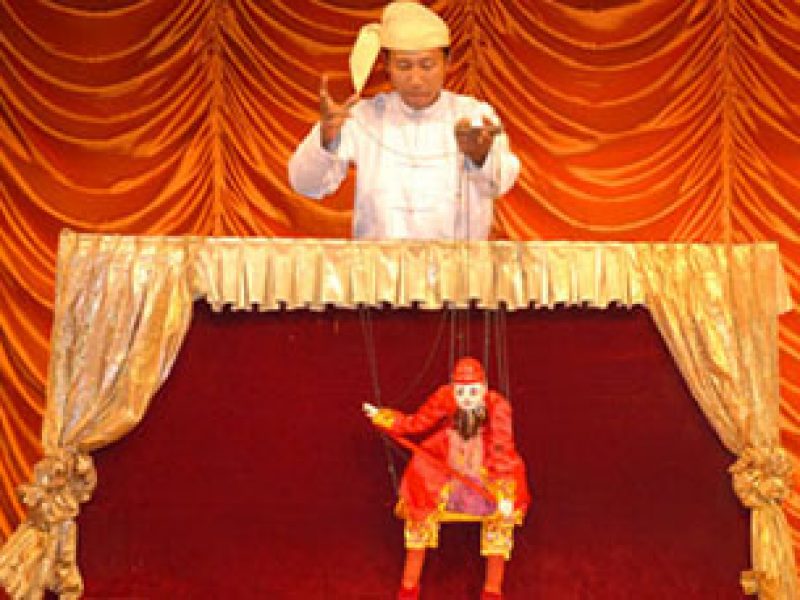
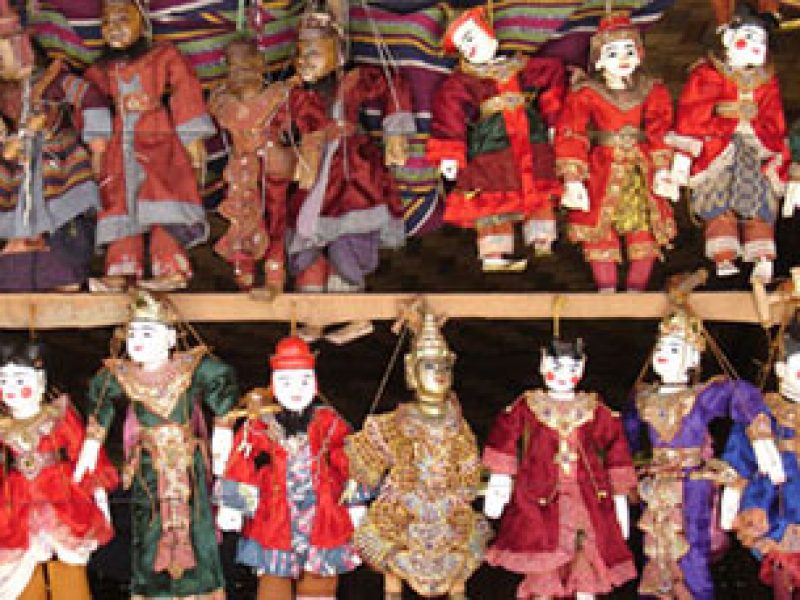
Soon the festival ground is filled with people. You I walk along the line of stalls where you can buy products from far and near-glazed earthen-ware. hand woven cottons. bamboo and cane baskets. mats. woodwork. boxes made of toddy palm leaves which come in all sizes. from the smallest toy things to huge packing cases. their outsides are woven in attractive designs.
The festival has all the trimmings of a trade fair; ferns wheels. merry-go-rounds. and of course. marionette shows. The stage for the show is built of bamboo. Tradition decrees that it is not built with its back to the village. It slopes slightly towards the audience who sit on the ground; they bring their own mats. It is an open air show.
The Making of the Puppets
The carving of puppets
Some puppets-masters made their puppets themselves but they were generally manufactured by specialists. Yamanay wood was preferred to all others for its solidity and lightness. This species grows in Myanmar’s highest and coolest regions and reaches several dozen metres in height. It was so much believed to have beneficial powers that it was even used in the making of sacramental thrones. Craftsmen for whom it was a specialty to make puppets carefully selected the tree which they thought fit for their purpose and let it dry. It was indeed considered a good omen that all puppets should be carved out of the same tree. The latter was then cut into pieces. each of which was marked on its upper part so that the characters would not be made upside down. and again they were dried. The dried pieces were then plunged into water. the immersed parts being used for the making of male characters whereas the parts in the open air were used for the making of female characters.

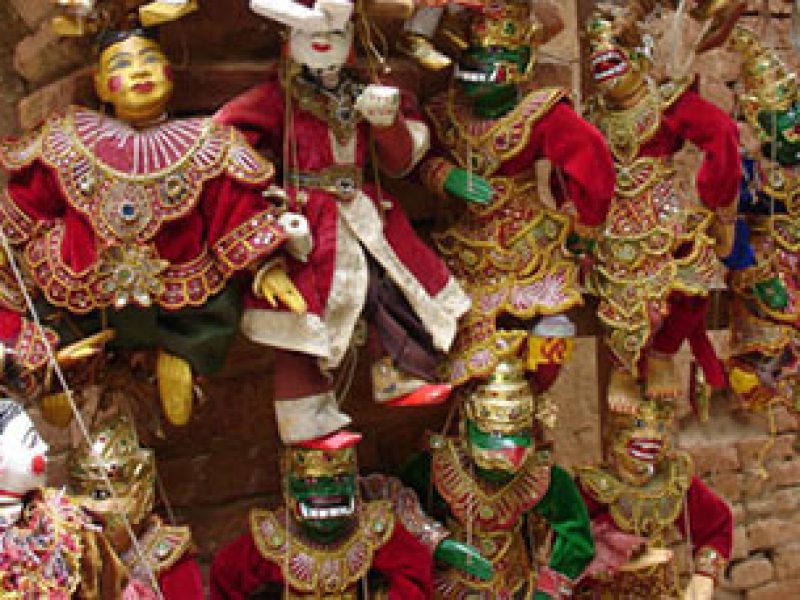
The head measured one length. the body six. which made a total of seven lengths equivalent to between 60 cm and one meter (the latter being rare. due to the weight of the puppet). The arms measured half the body’s length without the head. which itself measured three times the nose in length and five times the eyes in width. The ministers are among the tallest puppets and the page among the smallest. The forehead’s. shoulders’ and hips’ width. together with the delicacy of the nose. hands and waist of female figures respected very accurate measures. These criteria were also adapted to the traditional dances that women were supposed to execute.
Real human hair was attached to little holes in the skull. Arranged in a row forming a circle. they went from the top of the forehead to the nape of the neck. Nowadays. they are replaced by horse hair. Moreover. carvers often realised the Prince and Princess’ eyes in onyx and white jade. The neck comprised a piece that brought the head and shoulders together and allowed a lighter animation. Finally. the body was articulated thanks to cloth joins and animated by strings which were tied to the neck. shoulders. elbows. wrists. thighs. knees and waist (with the exception of Nat Pyet. who had a round belly).
Although the most ancient puppets that were found date back to the XVIIIth century. excavations in small villages have revealed scaled-down limbs that seem to have belonged to dolls or puppets. though they were not made out of wood but out of clay.
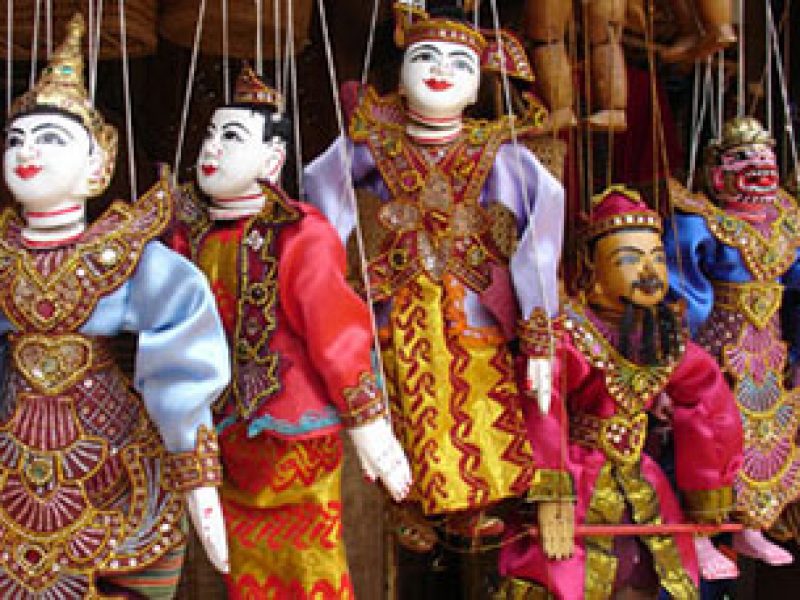
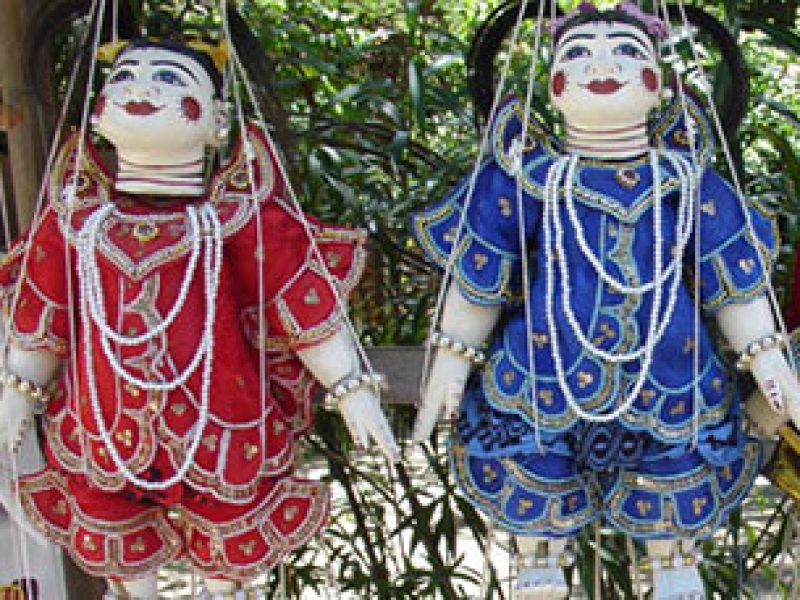
Painting and tattoos
For centuries. the same technique has been used for the painting of puppets. for no chemical painting has yet been able to match the porcelain colour which characterised them in ancient days. They are painted with a mixture made of talcum powder or lime that has been brought to a powdery substance on a spherical stone (also used to grind the Thanakha. a tree whose bark is utilised by women and children as make-up as much as a protection against the sun and the mosquitoes). and water. The result is a kind of dough. Tamarind seeds are also heated for about five hours before they are crushed and brought to an greasy cream. These two dough’s are then mixed and used for the painting of good characters’ faces. Ten layers or so are necessary to obtain a lasting painting. This operation must be executed within a day and in the sunlight so that the different layers of painting dry rapidly. In old days. a little cushion was placed on the puppets’ heads during transportation so that they would not be damaged and once a year they were entirely cleansed and painted anew.
A little vermilion obtained thanks to some mercury oxide. the hinthapada. was mixed with the basic white painting to paint evil faces. Black. which was used to paint the eyes and eyebrow. was made with a mixture of soot. tamar rein and fish’s bile. the ngagyin (Cirrhina morigala). Nowadays. the use of ink is more widespread. However. vermilion is still used for the painting of hands. mostrils. feet and lips; it is also used in making the circular motifs which were eventually filled with greasepaint on the cheeks of pages. imitating women’s and children’s thanakha. The face’s expression was realised with much care since it was supposed to convey joy. grief or anger.
Traditionally. tattoos embellished or protected their bearer against the blows of misfortune. Because they believed in the existence of spirits and dark forces. the Burmese were covered with them and symbolically reproduced them onto the puppets. As said Nicolo di Conti. a Venetian merchant who came to Burma in 1435 : “All inhabitants. men and women. decorate their flesh using an iron point that paints them in an indelible manner. Thus are they painted for the rest of their days”. These tattoos can be located on the face. the chest. the pelvis. the feet. the hands and the limbs.
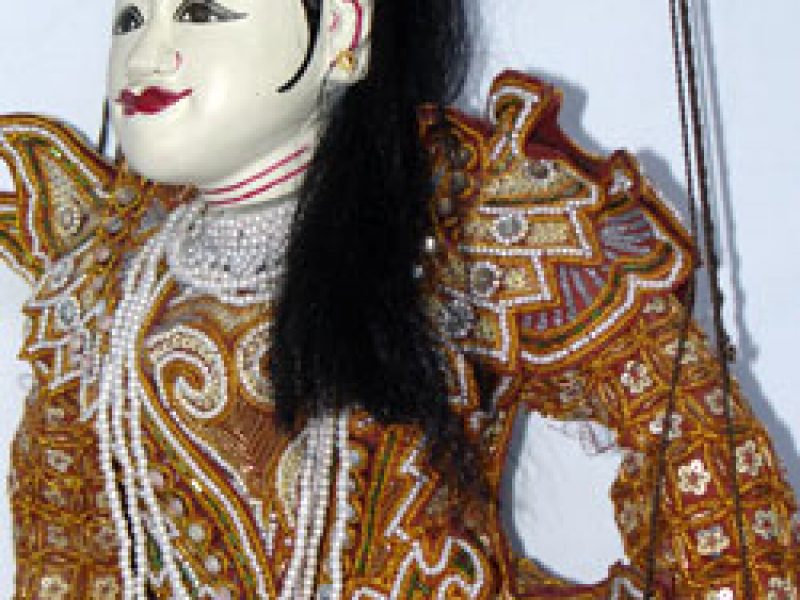
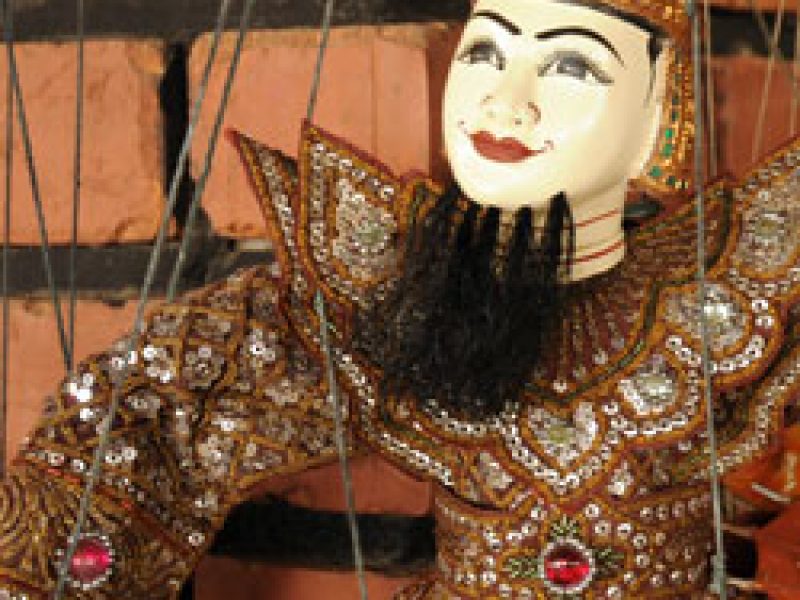
Clothes and strings
The same material (sequins and glass pearls) was used both in the making of royal and puppet clothes. During the XVIIth century. these sequins were imported from India; in the years that followed they began to be manufactured in Burma. Some villages lived entirely on their manufacturing and a few years ago. families that lived on this sole activity could still be found in the neighborhood of Mandalay. To produce these sequins. one had to roll copper or brass strings around a stem and then cut the latter so as to obtain small metal rings. Nowadays they are made out of plastic. As for glass pearls. they were and still are made of a superimposition of glass. resin and polished metal which was then coloured in order to make it take the aspect of a cabochon.
These “jewels” were first embroidered onto silk or velvet material. then cut. assembled and sewed to be used as shoulder-straps. wristbands and various ornamental features for the noble characters to wear (Princes. Princesses. Kings and Nats). Very few puppets were soberly dressed and all but the hermit wore decorations.
Most of them were hung by ten to twenty strings (kyo). with the exception of the Naga (hung by two strings) and some others that might even have been hung by more than twenty. according to the animators ability. These strings were essentially white so that they remained invisible. whenever the scenery was darker. the strings coiiih be grey or black. These strings were solidified. protected against moths and dipped for several days in the juice of the “te” fruit. a local tree (Diospyros Burnianica) whose acid allowed to disentangle the strings easier. The five main strings. called “life strings” were tied to the shoulders. the spine and the temples.
The Prince’s heels and toes were usually also tied to strings. which was not the case of the Princess. for whom it would not have been acceptable to dance with open toes in front of the audience. On the contrary. only the alchemist’s. the page’s and the ogre’s knees were tied to strings. Strings could also be hidden inside the body to discreetly animate parts such as the eyes or mouth. The latter then opens and closes thanks to strings going through the head. as was the case of some jesters who could move their tongue and eyelids. though these puppets seem to be of a more recent manufacture.
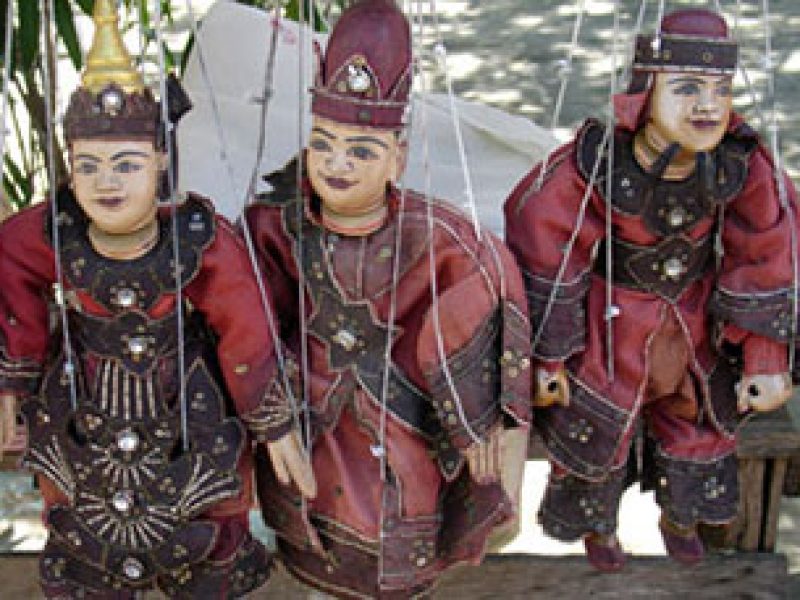
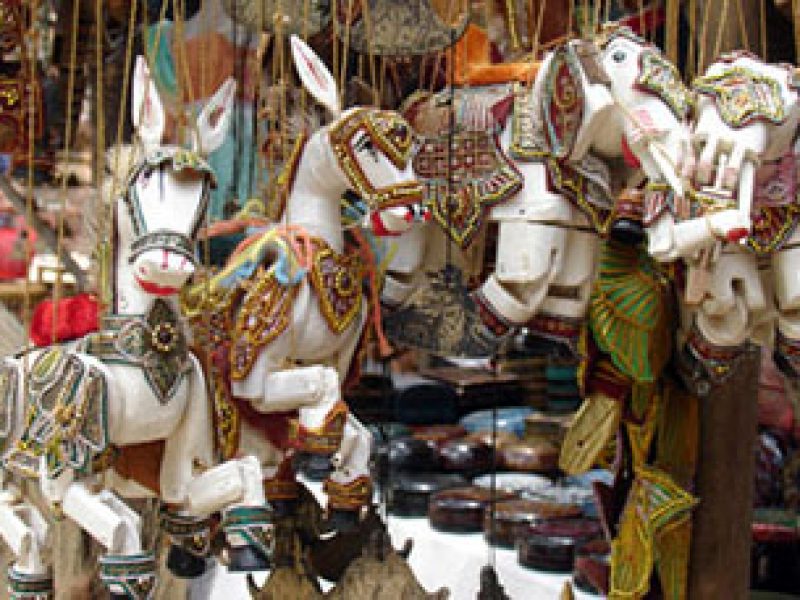
Marionette stage
The stage is bare except for a green branch stuck in the middle against the white backdrop about two and half feet high and a kadaw-pwe. which is an arrangement of two bunches of bananas and green coconut on a tray decorated with flowers wrapped in green banana leaves. Kadaw-pwe literally means an offering of respect; it is an important item in any Myanmar celebration both in family circles and in public.
Ritual dance
The show opens with the ritual dance performed by a female marionette to pay respects to the guardian spirits of the area. It is a formality to ‘pay respects to those to whom respect is due’; through this dance the troupe requests the powers that be to waive away all the dangers that may be lurking on the festival grounds The ritual dance is exciting and boisterous; the marionette in red and pink costume dances to the booming (of the orchestra. The opening bars of the song call for a crescendo and connoisseurs judge the vocal virtuosity of the troupe by the way the ritual song is sung. The orchestra men also show their artistry and prowess that match the song and dance of the votaress the manipulator of which has to take the challenge and give an exhibition of his dexterity. In this way the ritual dances serve as a ‘trailer’ for the audience.
Primeval forest scene
After the ritual dance comes the dance of the animals and mythical beings in the primeval forest. It is also supposed to be the beginning of the world. The orchestra prelude the scene with boisterous music which symbolizes chaos before the earth came into being.
The first to appear is the horse; according to the Buddhist concept of the universe. the first planet to appear on the firmament is Asavani. the galaxy of stars shaped like a horse’s head. The coming of the horse therefore tells the audience that the earth and the sky have come into being out of the chaos.
After the horse comes the elephant. stepping with grace and dignity. Soon the stage is full of animals. tigers on the prowl. birds in the air. and the monkey up to his antics. Mythical beings like the dragon. ogre and zawgyi (demigod or magician) also come in the dance. They |lend an air of fantasy. glamour and the mysterious ¦beauty of the wilds.
The play; scenery and props
Scenic background. until recently was not used because marionettes show better against the white background. The props used are not many; tree branch to convey the idea of a forest. the throne for the king’s audience hall and the couch for the boudoir.
The play invariably opens with the king holding I court. Sometimes this scene is hardly part of the story. Hie court scene however tells the audience that after I the primeval forest scene. human society with law and I order has come into being. The king and the ministers. I in the course of their conversation. reveal where the I action of the play is to take place and who are to be the I main characters. In this way the scene ‘lays the foundation of the plot’ as the saying goes.
One thing about the Myanma marionette show is that its strength lies in the lyrical beauty and the epic grandeur of the dialogue which is rendered in song. I arias. recitatives and commentaries in rhymed prose supported by the orchestra.
Usually it takes two to present a marionette on the stage. one to recite or sing and the other to manipulate the strings in co-ordination. Sometimes an artiste might be able to do both but such ones are rare.
Importance of the court scene
There is a saying that no play is complete without the royal court scene with the king and ministers. but it is a fact that the scene is boring to the audience. It is. however. considered auspicious to open the play with this scene. In the colonial days. it was a reminder of Myanmar’s sovereignty which had been lost. The glorious music of the orchestra and the song in praise of the king and his realm awakened nostalgic memories in the old who passed them on to the young.
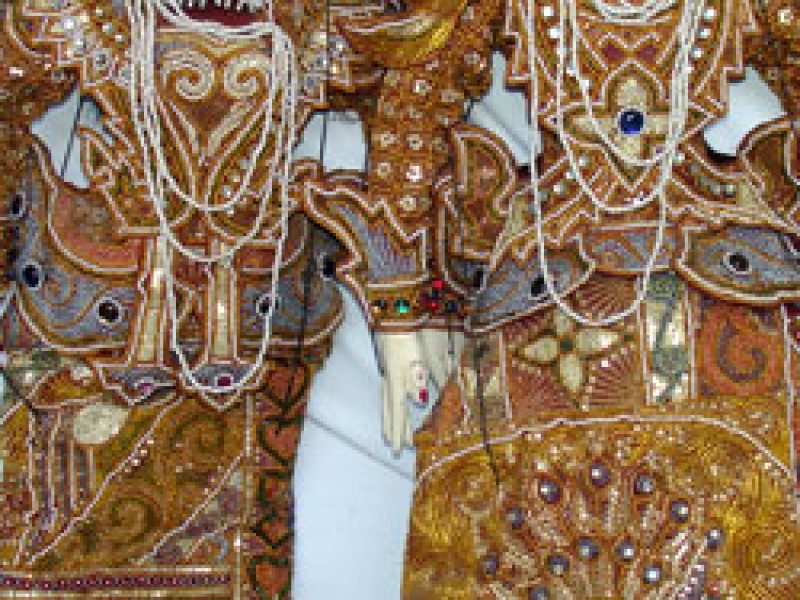
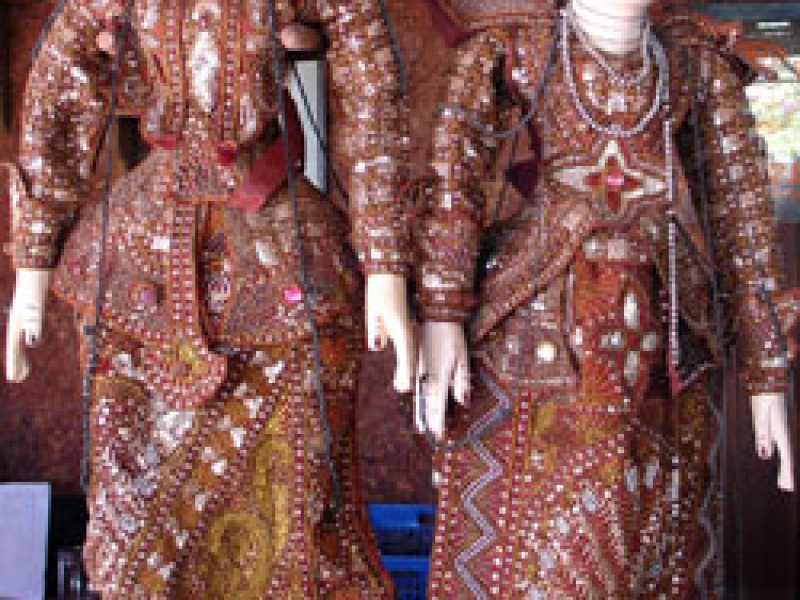
The duet dance
After the court scene comes the much awaited hna-par-thwar. the duet dance which is a love scene. The scene does not do much to help the story move forward; it only represents the two leading characters of the play in the state of lyrical happiness. The scene calls for the artiste’s mastery of singing. elocution and histrionics and the co-ordination of marionettes to the texts of the songs and recitatives. and the music of the orchestra.
All-night performance
The marionette show goes on all through the night. This often makes a non-Myanmar ask in surprise: “How is it possible? Why all night?” The Myan-mars in turn are surprised by the questions. As long as they remember. the shows go on all night; never mind how or why.
Every now and then some well-meaning people make attempts to shorten the duration of the show but with little success. Some say that if the show finishes in the middle of the night. it is not easy to get transport home. In rural areas. people come from other villages over long distances and they come prepared to stay the whole night. Others say that the Myanmars love fun. music and entertainment in such a prodigious manner that they are content with nothing less than whole night entertainment.
Leisure and easy-going ways may have something to do with this. Today even though leisure is much curtailed. all-night shows go on and they are enjoyed not only in small towns and rural areas but in cities too.
Presentation of the puppets
We have seen that the number of puppets had been set to twenty eight in the course of the XVIIIth century under the Nyaungyan dynasty. Even if the 1821 edict is at the origin of the creation of eight additional puppets. the latter remain optional and are only used occasionally according to the companies and the plays of this repertoire. The number of twenty eight is in fact linked to an important buddhistic work. the Abhidhama Pitaka. Tackling Buddhism in a psychological and metaphysical way. this book mentions the twenty eight attributes of the human body which are symbolically carved on the puppets. Shows staging an odd number of puppets were by the way avoided.
The twenty eight puppets of the 1776 treaty are :
1- Natkadaw: medium
2- Aphyo-daw: maid of honour
3- Myin: horse
4- Myauk: monkey
5- Taw-belu: ogre or jungle demon
6- Nan-belu: ogre or city demon
7- Kyar: tiger
8- Sin-net: black elephant
9- Naga: dragon serpent
10- Garuda: mythical bird
11- Zawgyi: magician-alchemist
12- Nan Yin Wun: prime minister
13- Pyi De Yay Wun: minister of the Interior
14- Atwin Wun: general secretary
15- Myo Wun: Governor
16- Thu Nge Daw: page
17- Bayin: King
18- Mintha: Prince
19- Minthamee: Princess
20- Lu Shin daw – Than Cho: jester
21- Lu Shin daw – Than Pyet: second jester
22- Mintha-gyi: white-faced Prince Regent (good)
23- Mintha-gyi: red-faced Prince Regent (evil)
24- Thagyar Min: King of celestial spirits (Nat)
25- Nat Pyet: evil spirit (Nat)
26- Brama or Sama-deva: good spirit (Nat)
27- Ponna: astrologer (evil)
28- Ya-thay: hermit or monk
Since the 1821 edict did not make a list of the additional puppets. it is impossible to assert that the following were not anterior to the edict:
29- Kyee-to-yway or Wun-bo: parrot
30- Mi-gyaung: crocodile
31- Sin-phyo: white elephant
32- A-po-oh: old man
33- A-may-oh: old woman
34- Mi-baya: Queen
35- Sone or Meinma-gyan: witch or evil woman
36- Mote-soe or Lu-gyan: hunter or evil man
This list is far from being exhaustive and according to the companies and the era. other puppets can yet be encountered such as the pig. dog. ogress. lion. owl. actor or actress.
